Complete Solutions to QUESTION BANK of chapter CURRENT ELECTRICITY of Class 12 book with complete answers and questions
| Class 12 | PHYSICS |
| Chapter | CURRENT ELECTRICITY |
| MBD PUBLICATION | QUESTION BANK |
| Number Of Questions | 100 |
| Academic Year | 2023-24 |
A steady current of 1 A is flowing through the conductor. The number of electrons flowing through the cross-section of the conductor in 1 sec. is :
View SolutionA million electrons pass through a cross-section of a conductor in `10^(-3)` sec. What is the current in ampere ?
View Solution`10^6` electrons are moving through a wire per second, the current developed is:
View SolutionWhen current flows through a conductor, then the order of drift velocity of electrons will be:
View SolutionA charge following through a conductor per time is defined as
View SolutionThe drift velocity `v_d` of electrons varies with electric field strength E as
View SolutionWhen a current I is set up in a wire of radius r, the drift speed is `v_d`. If the same current is set up through a wire of radius 2r, then the drift speed will be
View SolutionTwo wires of same material but of different diameters carry the same current I. If the ratio of their diameters is 2:1, then the corresponding ratio of their mean drift velocity will be:
View SolutionA copper wire of length 1m and radius 1mm is joined in series with an iron wire of length 2m through the wires. The ratio of current densities in the copper and iron wires is
View SolutionThere is a current of 40 ampere in a wire of `10^(-6)` square metre area of cross-section. If the number of electrons per cubic metre is `10^(-29)`, then the drift velocity is:
View SolutionA current of 5 A flowing through a wire of cross-sectional area `4xx10^(-6)m^2`. If the free electron density in the wire is `5xx10^(26) m^3`, then the drift speed of the electron will be
View SolutionA potential difference of 10V is applied across, a conductor of length 0.1 m. If the drift velocity of electrons is `2xx10^4` m/s, the electron mobility is_______`m^2v^(-1)s^(-1)`.
View SolutionThe drift velocity of the electrons in a copper wire of length 2m under the application of a potential difference of 100 V is 0.2 `ms^(-1)`. Their mobility is (in `m^2 v^(-1) s^(-1)`)
View SolutionThe mean free path of electrons in a metal is `5xx10^(-8)`m. The electric field which can give on an average 2ev energy to an electron in the metal will be (in v/m)
View SolutionWhen the length and area of cross-section both are doubled, then it's resistance
View SolutionA certain wire has a resistance R. The resistance of another wire identical with the first except having twice it's diameter is:
View SolutionThe resistance of a wire is R. If the length of the wire is doubled by stretching, then the new resistance will be
View SolutionDimension of resistance is:
View SolutionThe VI characteristics of four circuit elements are shown. Which of these is ohmic ?
View SolutionAn electric bulb has a rating 500W, 100V. It is used in a circuit having a 200V supply. What resistance must be connected in series with the bulb so that it delivers 500 W ?
View SolutionThe resistivity of material is expressed in:
View SolutionThe electric intensity ( E ), current density (J) and specific resistance (P) are related to each other
View SolutionA material B has twice the specific resistance of 'A'. A circular wire made up of 'B' has twice the diameter of a wire made up of 'A'. Then, for the two wires to have same resistance, the ratio `l_B/l_A` of their respective length must be:
View SolutionThe specific resistance of a wire is `rho`, it's volume is `3m^3` and its resistance is 3 ohm, then it's length will be:
View SolutionTwo wires that are made up of different materials have their specific resistance, lengths and area of cross-section in the ratio 2:3, 3:4 and 4:5 respectively. The ratio of their resistance is :
View SolutionThe electric field (E),current density (J) and conductivity `(sigma)` of a conductor are related as :
View SolutionA wire when connected to 220V mains supply has power dissipation `P_1` . Now ,the wire is cut into two equal pieces which are connected in parallel to the main suplly. Power dissipation in this case is `p_2`. Then `P_2:P_1` is :
View SolutionA bulb of 220V and 300 W is connected across 110v circuit .The percentage reducation in it's power is :
View SolutionThe power of a heater is 750 W at `1000^@C`.What will be it's power at `200^@C` if `alpha =4xx10^(-4)per^@C`?
View SolutionNumber of colour band marked on carbon resistors is :
View SolutionThe color code for a resistor of resistance `3.5 K Omega` with `5%` tolerance is:
View SolutionThe colour sequence in a carbon resistor is red, brown, orange and silver. The resistance of the resistor are:
View SolutionA wire of resistance R is cut into 'n' equal parts. These parts are then connected in parallel. The equivalent resistance of the combination will be:
View SolutionThere are n similar conductors each of resistance R. The resultant resistance comes due to be x when connected in parallel. If they are connected in series, the resistance comes out to be:
View SolutionIn the net work of resistors shown in the adjoining figure, the equivalent resistance between A and B is:
 View Solution
View SolutionThe potential difference between points A and B of adjoining figure is:
 View Solution
View SolutionThe current in the adjoining circuit will be:
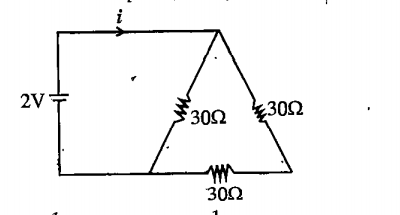 View Solution
View SolutionResistance of tungsten wire at `150^@C` is `133Omegha`.Its resistance temperature co.efficient is `0.0045^@C`.The resistance of this wire at `500^@C` will be :
View SolutionThe temperature co.efficient of resistance for a wire is `0.00125^@C`.At 300K ,it's resistance is 1 ohm.The temperature at which the resistance becomes 2 ohm is :
View SolutionThe resistance of a conductor is 5 ohm at `50^@C` and 6 ohm at `100^@C` .It resistance at `0^@C` is :
View SolutionA cell of emf R is connected with an external resistance R and P.D. across the cell is V . The internal resistance of the cell will be :
View SolutionA cell of constant emf is first connected a resistance `R_1` and then connected to a resistance `R_2`. If power delivered in both the cases is the same, then internal resistance of the cell is:
View SolutionA cell whose emf is 2V and thermal resistance is `0.1Omega` is connected with a resistance of `3.9Omega`. The voltage across the terminals of the cell will be:
View SolutionThe internal resistance of a 2.1 V cell which gives a current of 0.2 A through a resistance of `10Omega` is:
View SolutionIn a circuit consisting of two resistors ( 2 ohm and 7 ohm) and a cell of current of 0.9 A flows through 2 ohm resistor and 0.3 A through 7 ohm resistor. The internal resistance of the cell is:
View Solutionn identical cells each of emfE and internal resistance r are connected in series. An external resistance R is connected in series with this combination.The current through R is :
View SolutionTo draw maximum current from a combination of cells, how should the cells be grouped:
View SolutionTwo identical cells send the same current in `2Omega` resistance whether connected in series or parallel. The internal resistance of the cell should be:
View Solution32 cells, of emf 3V are connected in series and kept in a box. Externally, the combination shows an emf of 84V. The number of cells reversed in the connection is:
View SolutionKirchoff's first law i.e. `Sigmai=0` at a junction is based on the law of conservation of:
View SolutionThe figure below shows currents in a part of electric circuit. The current is:
 View Solution
View SolutionIn the given distribution, what is the value of I ?
 View Solution
View SolutionThe current in the arm CD of the circuit will be:
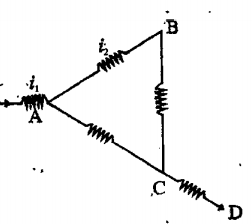 View Solution
View SolutionIn the circuit shown below, the potential difference between the points B and D
 View Solution
View SolutionThe resistance of four arms P,Q.R and S in a Wheatstone's bridge are 10 ohm, 30 ohm, 30 ohm and 90 ohm respectively. If the galvanometer resistance is 50 Ohm, the current drawn from the cell will be:
View SolutionThe meter bridge works on the principle of:
View SolutionShown in the figure below a meter bridge set up with null deflection in the galvanometer. The value of the unknown resistance R is:
 View Solution
View SolutionThe instrument among the following which measures emf of a cell most accurately is:
View SolutionThe length of a potentiometer wire is L. A cell of emf E is balanced at length L/3 from the positive end of the wire. If the length of wire increases by L/2 then the same cell will give balance point at length :
View SolutionThe figure below shows a network of currents is shown here. The current I will be:
 View Solution
View SolutionIn the network shown in figure, points A,B and C are at potentials of 70N, 0V and 10V respectively which of the following statements are not true.
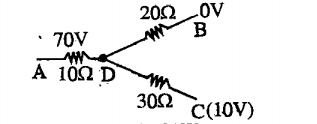 View Solution
View SolutionFour resistances `10Omega, 5Omega 7Omega and 3Omega` are connected so that they form the sides of rectangles AB, BC, CD and DA respectively. Another resistance of `10Omega` is connected across the diagonal AC. The equivalent resistance between A and B is:
View SolutionThe potential difference across the `3Omega` register shown in figure is:
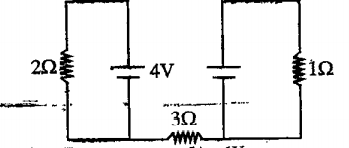 View Solution
View SolutionIn the arrangement shown in figure, the current through `5Omega` resister is:
 View Solution
View SolutionIn the circuit drawn, current following through 25V cell is:
 View Solution
View SolutionThe internal resistance of a primary cell is `4Omega`. It generates a current of 0.2A, in an external resistance of `21Omega`. The rate at which chemical energy is consumed which is providing the current is:
View SolutionTransmission lines transmit a voltage V volt to our houses from stations, then the power P supplied by them is proportional to:
View SolutionA, B and C are voltmeters of resistance R, 1.5R and 3R respectively as in fig. when some P.D. is applied between x and y, the voltmeter readings are `V_A, V_B and V_C` respectively, then:
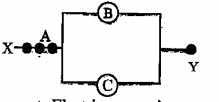 View Solution
View SolutionTwo cities are 150 km apart. Electric power is sent from one city to another city through copper wires. The fall of potential per km is 8 volt and the average resistance per km is `0.5Omega`. The power loss in the wire is:
View SolutionA potentiometer wire has length 4m and resistance `8Omega`. The resistance that must be connected in serires with the wire and an accumulator of emf 2V, so as to get a potential gradient 1mV per cm on the wire is:
View SolutionThree resistance P,Q,R each of `2Omega` and an unknown resistance S form the fourth arm of a Wheatstone's bridge circuit. When a resistance of `6Omega` is connected in parallel to S, the bridge gets balanced what is the value of S ?
View SolutionThe rate of increase of thermo emf with temperature at the neutral temperature of a thermocouple:
View SolutionIn producing chlorine by electrolysis 100 kw power at 125 V is consumed. How much chlorine per minute is liberated.
View SolutionThere are n cells in the circuit of figure. The emf and internal resistance of each cell are E and r respectively. The points A and B in the circuit divide the circuit into n and (N-n)cells. The current in the circuit is:
View SolutionThe rate of flow of charge what we call ?
View SolutionThe motion of which charge is the direction of conventional current.
View SolutionWhat is the number of electrons which constitutes a current of one ampere ?
View SolutionWhich is the biggest unit of current ?
View SolutionWhich is the smallest unit of current ?
View SolutionThe direction of flow of negative charge what we call ?
View SolutionWhat we call to the velocity of electron which is very small of the order of few millometer per second ?
View SolutionHow electric current varies with drift velocity .
View SolutionState ohem's law mathematically .
View SolutionWhat we call to any material in which electric current flow fairly well are called ?
View SolutionThe materials in which electric current flows fairly well are called ?
View SolutionThe material which do not conduct electric current are called .
View SolutionWhat is dimensional formula of resistance ?
View SolutionWhat we name the conductors which do not obey ohm's law?
View SolutionWhat type of group we expect between V and I in an ohmic conductor ?
View SolutionWhat is common to resistance connected in series ?
View SolutionKirchoff's current law is generalisation of what ?
View SolutionWhat is the condition of balanced wheatstone's bridge?
View SolutionWhat is Conventional current ?
View SolutionDefine unit of current.
View SolutionHow does drift velocity of electrons in a metallic conductor vary with increase in temperature ?
View SolutionIs electric current a scalar or vector quantity ? Give reason.
View SolutionIs a wire carrying current charged ?
View SolutionWhat is non ohmic device? State one example of it.
View SolutionHow is current kept continous inside a conductor ?
View SolutionWhat is the cause of resistance of a conductor ?
View Solution
QUESTION BANK questions and complete solutions for chapter CURRENT ELECTRICITY of MBD PHYSICS (ODIA ENGLISH) of Class 12
